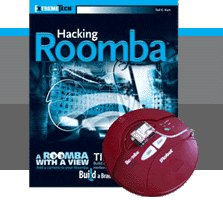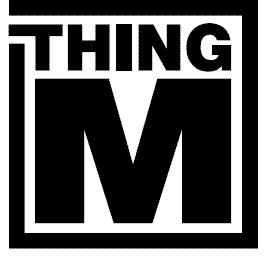I'm pleased to announce two exciting events, in the form of two websites.

First is the appearance of Tod Kurt's Hacking Roomba book, and its companion site, roombahacking.com. Tod is my friend and business partner, but (that notwithstanding) I still feel the book is still an exciting statement about technology and people's understanding and access to it (and an a fun way to get close to an otherwise difficult subject, robotics). Of the many books about hacking software, and homebrew hardware, this is one of the only ones that focuses on a single, cutting-edge appliance.
For me, this is an important milestone. For many years the trend in device design has been toward less end-user access to core functionality because the incentives for creating clarity about device functionality decreased in proportion to the increase in complexity and price competition. Cheap component prices mean there's little reason for developers to let people other than the manufacturers access the core of everyday technological objects. Even appliances, which designers once labored to make easily fixable, have become nearly disposable. I was recently surprised when I opened a 1970s blender and discovered that it was made to be easily repaired: the individual parts were clearly marked with part numbers and positioned to be easily replaced.
iRobot, whose company culture grew out of the MIT hacking tradition, designed the Roomba otherwise. They included a serial port on nearly every Roomba, and then they revealed the protocol for talking to that interface. Tod was one of the first to jump on this opportunity and wrote an excellent, broad ranging book about how to use this port (and the Roomba as a whole) to explore the possibility of personal robotics. He especially focused on uses outside the typical "robot fighting" genre that the majority of hobby robotics energy goes to. He feels that robots can do other things than push each other out of circles, flip each other over, or be the first to score a goal. His Roombas dance, draw and make music. As Tod puts it, the hacked Roomba can be a lover, not just a fighter.
The second announcement ( which I alluded to above) is that Tod and I have started a company, ThingM (pronounced "thingum" as opposed to "thing em"). We started this company close to a year ago, but we decided to put up a site to coincide with the launch of his Roomba book.
ThingM is a design and development studio focused exclusively on ubiquitous computing. We have many hopes for the company, but my dream is to rethink objects in the age of ubiquitous information processing. I believe that information processing can be considered a new kind of material in design (this is the basis of my Smart Furniture Manifesto, and furniture is one of the "object genres" that we have been studying), and that tangible networked objects can be considered a kind of projection of services, rather than mere standalone entities. At ThingM we aim to create a new class of smart everyday objects that abandon the idea of computers as general-purpose devices with a screen, a keyboards and a mouse. Our goal is to change the fundamental nature of all designed objects using pervasive networking and computing. In this, ThingM can be considered a combination of an interaction design studio, an industrial design studio, an engineering consultancy and a software development house, but really, we're a ubiquitous computing studio. Expect to hear more from us in the upcoming months.
Thanks to Judith Zissman, who helped us envision and produce these two sites (in addition to doing much of the site design and production, editing and basically everything else). Her contribution was instrumental, as it was with the Sketching in Hardware conference over the summer (the first ThingM product, if you look at the bottom ;-). Sonia Harris talked us (really me) through a bunch of overly-nebulous ideas and overly-specific requests to design the ThingM logo. Thank you!
[and thanks to Phil Torrone for blogging Tod's book on MAKE!]





Fantastic news, way to go with the site launch!
congrats!